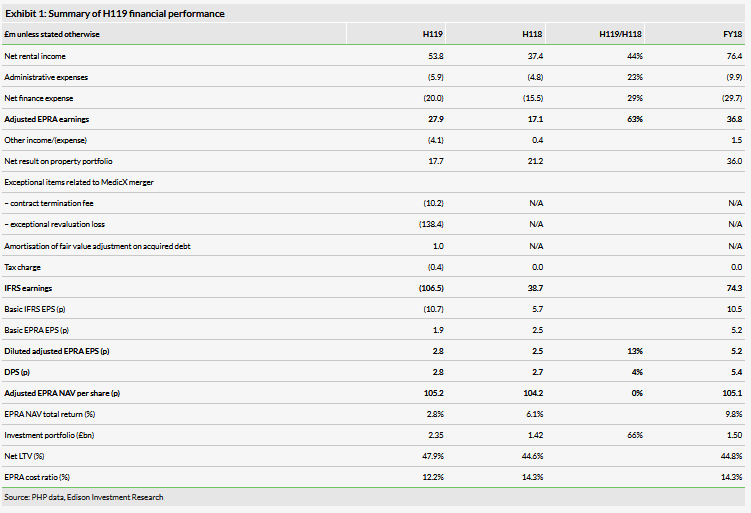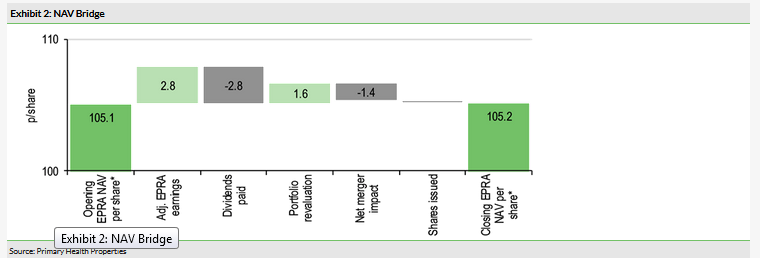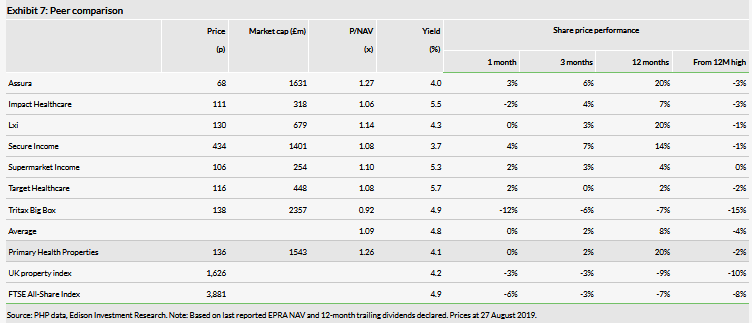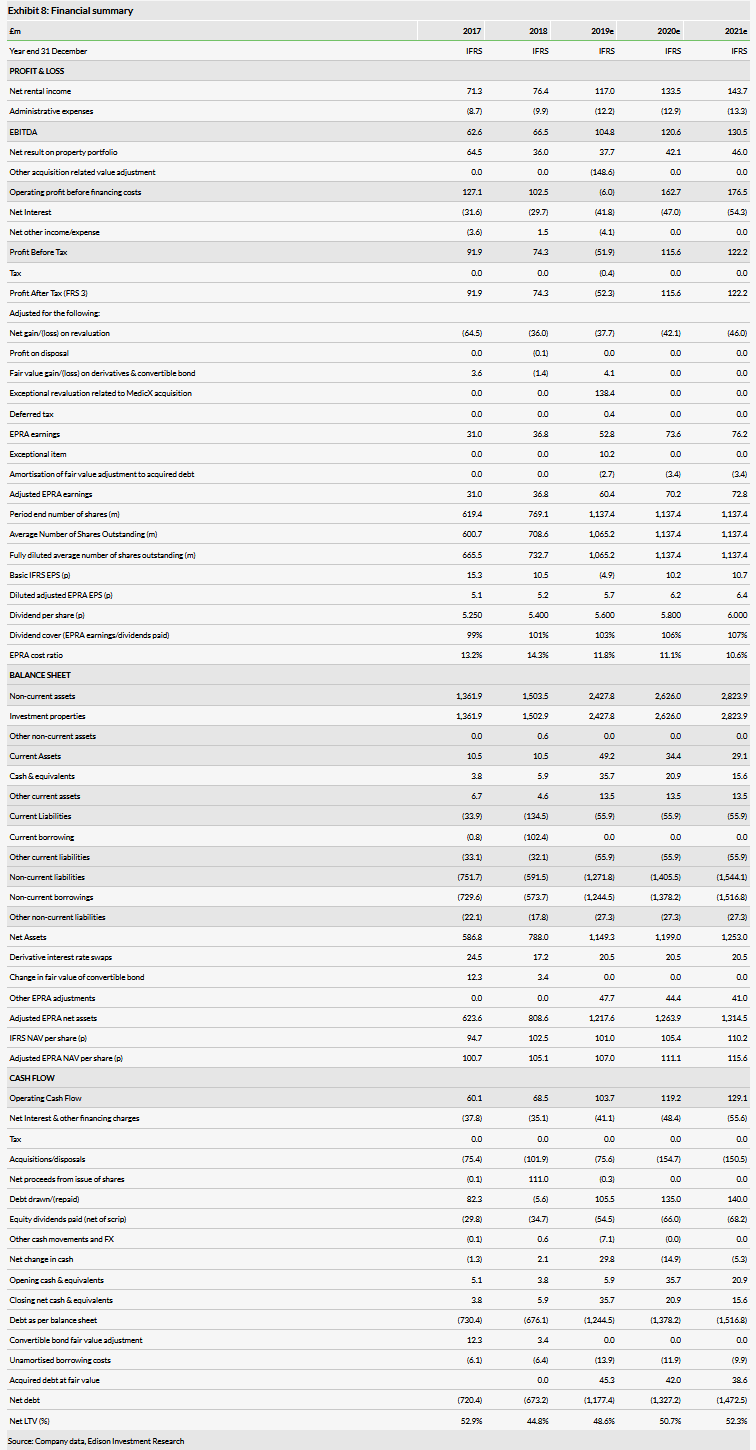
Primary Health Properties' (LON:PHP) recent interim results showed strong underlying progress enhanced by a first-time contribution from MedicX (for three and a half months) and early achievement of the targeted merger operating synergies. Accelerating rental growth, ongoing asset management initiatives, a strong pipeline of acquisition opportunities and capital resources to fund these all bode well for future growth in recurring earnings and dividends.
Strong underlying performance and merger delivery
H119 adjusted EPRA earnings increased by 63% to £27.9m and EPS by 13% to 2.8p. Of the total, PHP’s existing business contributed £20.3m (H118: £17.1m) and MedicX contributed £7.6m in the three and half months since the merger completed. Dividends increased by 3.7%, the 23rd year of growth, fully covered by adjusted EPRA earnings, and the company is well on target to meet its full year DPS target of 5.6p. Adjusted EPRA NAV per share was little changed at 115.2p and including dividends paid the adjusted EPRA NAV total return was 2.8% or a little more than 4% excluding c 1.4p of negative merger related effects. Our adjusted EPRA EPS forecasts are increased by c 2–4% for each of next three years. Our forecast DPS growth remains unchanged but with cover increased there is scope for a positive surprise.
Well placed for future growth
The merger brought together two complementary high-quality portfolios and created a scale platform, well placed to profitably address the substantial investment needs of the primary healthcare sectors in both the UK and Ireland. In both countries there is broad political will to reform healthcare provision, placing more emphasis on primary care to meet the increasing healthcare needs of growing and ageing populations. The requirement for larger, more flexible, higher-quality premises will provide significant investment opportunities for the enlarged group in coming years. The current pipeline of opportunities totals c £150m, including c £70m of properties that are in solicitors’ hands and subject to contract.
Valuation: Secure income with growth
PHP offers an attractive and growing dividend, fully covered by earnings. Income visibility is strong, with revenues supported by secure, long-term income, substantially subject to upward-only review, with little exposure to the economic cycle, or fluctuations in occupancy. The complementary nature of the merger and added scale have enhanced future growth prospects.
Business description
Primary Health Properties (PHP) is a long-term investor in primary healthcare property in the UK and the Republic of Ireland. Assets are mainly long-let to GPs and the NHS or HSE, organisations backed by the UK and Irish governments, respectively. The tenant profile and long average lease duration provide an exceptionally secure rental income stream.
Transformational half year and positive outlook
PHP’s all share merger with MedicX completed in March, bringing together two complementary high-quality portfolios, focused on modern, flexible, purpose-built, primary healthcare facilities located across the UK and Ireland. The combination has brought immediate cost savings while building a much stronger platform, well placed to profitably address the substantial investment needs of the primary healthcare sectors in both countries.
H119 saw good earnings growth from PHP’s existing business, enhanced by a first-time contribution from MedicX (for three and a half months) and early achievement of the targeted operating synergies of c £4m pa. The group is well on track to deliver its 23rd year of consecutive dividend growth, with prospective dividends fully covered by earnings. While integrating the two businesses, PHP has continued to selectively increase the portfolio, particularly in Ireland, and the pipeline of further acquisition opportunities is strong. Since the period end PHP has issued £150m in 2.875% unsecured convertible bonds, contributing to a continuing reduction in the average cost of finance.

Recurring earnings grew strongly during H119. The key features were:
Adjusted EPRA earnings increased by 63% to £27.9m and adjusted EPRA EPS by 13% to 2.8p. Of the total adjusted EPRA earnings, PHP’s existing business contributed £20.3m (H118: £17.1m) and MedicX made a three-and-a-half-month contribution of £7.6m. In addition to the normal EPRA adjustments to the IFRS earnings, adjusted EPRA earnings adds back the £10.2m one-off exceptional expense that was incurred to terminate the MedicX investment advisory agreement with Octopus Healthcare, and excludes the £1.0m non-cash recurring amortisation (a positive item in IFRS finance expenses) related to the fair value adjustment on fixed rate debt previously acquired by MedicX.
Net rental income growth of 44% reflected the merger, portfolio acquisitions and continuing improvements in the pace of rent growth. Rent reviews agreed in the period showed an average uplift of 1.9% pa, adding £0.9m pa to rent roll (FY18: 1.4%, adding £1.1m pa).
Administrative cost growth benefited from the early achievement of the £4.0m pa operational cost savings targeted in the merger, including the impact of revised management fee schedules and other administrative cost savings. Excluding performance incentive fees (PIF), administrative costs grew by 19% to £5.0m compared with the 66% growth in the investment portfolio to £2.35bn. Including a PIF accrual of £0.9m (H118: £0.6m) administrative costs grew 23% to £5.9m. Reflecting only three and a half months of merger synergies, the EPRA cost ratio declined to 12.2% (FY18: 14.3%), likely to be among the lowest if not the lowest in the UK REIT sector, and should fall further. The increased PIF accrual reflects the strong returns generated by PHP in FY18 and H119.
Higher underlying net interest expense reflected the debt acquired with the MedicX merger, offset by the reductions in the average cost of debt achieved in FY18. In July, post the period-end, £150m of 2.875% unsecured convertible bonds were issued, and £75m of 5.375% retail bonds were repaid at maturity, resulting in a further 25bp reduction in the average cost of debt to 3.75%.
Dividends increased by 3.7% in H119, the 23rd year of growth, and were fully covered by adjusted EPRA earnings. Quarterly dividends of 1.4p per share were paid in February and May and a third quarterly DPS of 1.4p will be paid on 23 August. The company expects to pay 5.6p for the year barring unforeseen circumstances and intends to maintain its policy of paying a progressive dividend that is covered by earnings in each financial year.
Statutory earnings reflect non-recurring merger impacts as well as net property revaluation gains. The merger effects were overwhelmingly non-cash and reflected the accounting treatment for the all-share merger. The increase in the PHP share price during the merger process, to 129.2p at closing, increased the value of the shares issued and the total consideration paid for MedicX (which also included £14.5m in transaction costs) to £455.1m. The fair value of MedicX assets acquired was £316.7m, resulting in an exceptional revaluation loss of £138.4m. Only the £14.5m in transactions costs was reflected in a cash movement. Additionally, the £10.2m expense incurred to terminate the MedicX investment advisory agreement with Octopus Healthcare is included in IFRS earnings. The other items included in IFRS earnings but not in adjusted EPRA earnings were:
Net property revaluation of £17.7m or 0.8%, including £3.2m in respect of the assets added by the MedicX merger. The revaluation surplus was driven by rental growth with the blended net initial yield remaining stable at 4.85%.
Other expenses of £4.1m reflecting fair value movements on interest rate derivatives and convertible bonds.
Non-cash amortisation of the fair value adjustment to acquired debt of £1.0m.

Including dividends paid in the period, the adjusted EPRA NAV total return was 2.8% or a little more than 4% excluding the merger related effects. Adjusted EPRA NAV per share was little changed during H119 at 105.2p (end-FY18: 105.1p) with recurring earnings distributed as dividends and property revaluation offsetting one-off merger impacts. In addition to the normal adjustments for deferred tax and fair value movements on interest rate hedging derivatives and on convertible bonds, adjusted EPRA NAV adds back the fair value adjustment on MedicX acquired fixed rate debt (net of amortisation).
Attractive scale portfolio with good growth prospects
The merger brought together two complementary high-quality portfolios and has created a strong platform for further growth. Continuing signs of a pick-up in open market rents provide a positive backdrop for organic rental growth driven by ongoing asset management. The pipeline of further acquisition opportunities is strong and, as we discuss in the financial section below, PHP has the financial resources to pursue these.
Strong portfolio metrics

At 30 June 2019 the portfolio comprised 483 assets, including eight on-site forward funded developments, externally valued at £2.35bn, reflecting a net initial yield (NIY) of 4.85%. The rent roll was £125.6m including the development assets at completion. The merger with MedicX added a complementary, high-quality portfolio of 167 assets valued at £804m and the group continued to selectively grow its portfolio through acquisitions, adding four assets in the period and exchanging contracts to acquire The Meath Primary Healthcare Centre in Dublin for €10.9m, its 484th asset and its15th asset in Ireland.
The portfolio metrics are strong with the normal high occupancy (99.5%), a strong tenant covenant (90% UK and Irish government backed), and long weighted average unexpired lease term (WAULT) of 13.0 years. The non-government backed rents are predominantly (9%) from low-risk pharmacies co-located within the health facilities. Only 1.6% of total rent is due to expire over the next three years. A further positive indicator of the quality of the assets, average lot size has continued to increase and is now £4.9m (end-FY18: £4.8m). Properties valued at more than £3m represent 83.5% of the total and there are only eight assets valued at less than £1m. The UK portfolio is well spread geographically, with London and the South East weighting up to 20%. By value, Ireland represents 7% of the portfolio and we would expect this to increase to at least 10% over time.
Organic growth from developments and asset management
The enlarged group had eight forward funded developments onsite at the end of H119 with a net development cost of £59.5m and costs to complete not yet incurred of £32.7m. We expect these to contribute a little more than £3m pa to rental income at completion which, for all eight assets, is expected in the current year. Since the start of H219, two of the assets have already completed, with an aggregate development cost of £6.4m.
Organic rental growth from the existing asset base remains an area of strong focus. This mainly arises from rent reviews and through asset management projects (extensions, refurbishments, and lease re-gears), which provide an important opportunity to increase income, extend lease terms, and ensure that the properties continue to meet the needs of the tenants and the services they provide. This benefits income and capital values. In H119 eight such projects were completed, with three currently on site and 11 further projects approved and due to commence shortly. The projects represent £4.9m in investment, will generate £0.3m of additional annualised rental income, and will extend the WAULT on those properties by an average 17 years. PHP has a pipeline of more than 60 potential projects.
Rent growth showing signs of picking up

Low rates of inflation (in contrast to land and building cost inflation) and low open-market rent review increases in recent years have resulted in muted overall levels of rent growth, especially compared with the broader, mainstream commercial property market (industrial and office assets in particular). However, the accelerating trend of the past three years continued in H119 and comes at a time when rental growth in the broader market has weakened. The average uplift on rent reviews completed in H119 was 1.9%, which compares with an average 1.4% in FY18.
Open market rent reviews account for 68% of PHP’s rents, with the balance represented by indexed/RPI based rents (25%) or fixed uplift agreements (7%). After several years of failing to sufficiently capture the strong rise in land and build costs there are increasing signs of acceleration and this has the potential to be a key driver of future organic rental growth. The slow growth in open market rents in recent years is attributed to financial pressures and reorganisation within the NHS that slowed decision making and the commissioning and development of new primary healthcare facilities. This dearth of new developments has restricted the opportunities for increased land and building costs to be adequately reflected in the rent reviews for existing assets and threatens to restrict the flow of much-needed private investment to support modernisation of the primary healthcare estate. There is now a growing optimism that this is changing as NHS reforms bed down, plans take shape and development activity picks up. In H119 an average 0.9% pa uplift in open market rents (3.0% on RPI-linked and 3.1% on fixed uplifts) was noticeably higher than the average 0.4% achieved in FY18 (2.7% on RPI-linked and 2.6% on fixed uplifts). At the end of H119, 197 open market rent reviews remained outstanding, representing a substantial estimated rental value (ERV) of £32.4m, an uplift of c £1.6m to the current passing rent and equivalent to a 1.7% pa increase.
Strong acquisition pipeline
In both the UK and Ireland, there is broad political will to reform healthcare provision, placing more emphasis on primary care to meet the increasing healthcare needs of growing and ageing populations. The requirement for larger, more flexible, higher-quality premises will provide significant investment opportunities for the enlarged group in coming years.
In addition to strengthening PHP’s ability to fund investments, the merger with MedicX has added complementary development partners, enhancing its ability to source opportunities. The pipeline of further potential acquisitions remains strong in both the UK and Ireland totalling c £150m, which includes £70m of properties that are in solicitors’ hands and subject to contract.
With access to attractive marginal funding rates (c 2.7% in the UK and c 1.7% in Ireland) and low marginal management fee rates (0.27%) the spread between income returns after financing and other costs remains clearly positive, and especially so in Ireland.
Financials
Forecasts increased

We have increased our adjusted EPRA earnings and adjusted EPRA EPS forecasts by 3–4% for each of the next three years (Exhibit 5). The forecast increase results from a combination of slightly lower costs and slightly higher revenues, building off the H119 performance.
Underlying growth assumptions
They key underlying forecast assumptions we make relate to asset growth and funding:
We assume new investment commitments of £70m in H219, reflecting the pipeline of acquisitions at an advanced stage reported with the interim results, and taking the total for the year to just over £100m. We continue to forecast an increase in commitments to £150m pa in FY20 and FY21. We assume a mix of fully let completed assets and forward funding commitments, in both the UK and Ireland.
For the UK we assume a blended cash yield on investment of 4.75% for standing assets and 5.0% for development assets and in the RoI we assume 5.25% for standing assets and 5.75% for development assets. The blended yield on our assumed new commitments is 5.13% in FY20 and FY21 and a little higher in H219 when we assume a higher weight of development assets. We assume a blended average 2.0% pa rental growth.
For commitments to forward funding agreements the cash is deployed over time causing our forecast cash investment to lag the commitments in FY19, although the two converge in subsequent periods. We expect PHP to fund its future growth with a mix of new equity and debt capital, but for modelling purposes we assume all debt funding and no equity issuance. Our debt funding assumptions for the period from end-H119 include the £150m of convertible bond issuance and £275m of additional secured debt. The secured debt assumption is ahead of the c £200m available headroom at end-H119 and anticipates the arrangement of additional facilities. For new secured debt we assume a rate of 3.3% (previously 3.5%). This is above the current marginal rate applicable to PHP’s existing facilities of less than 3% in the UK and less than 2% in Ireland, but we feel is more representative of medium-term funding costs.
Our cost estimates are substantially driven by the revised fee schedules in place following the merger with MedicX. In addition, and in line with our overall return expectations, we allow for £1.8m pa (previously £1.0m pa) of performance incentive fee (PIF) payments to the investment adviser.
We make no assumption of changes in market valuation yields (either up or down) and reflect the assumed rental growth in gross revaluation gains. We estimate that a 0.1% decrease in the portfolio net initial yield would increase FY19e EPRA NAV per share by c 4p, with a 0.1% increase in net initial yield having a similar negative impact.
Funding available for growth
The enlarged group has a broadly diversified portfolio of debt facilities, with a long average maturity, substantially fixed rate or hedged. The average cost of debt has continued to reduce and management expects a further improvement.
Total debt facilities amounted to £1,376m at end-H119 of which £1,138m had been drawn. 93% of the drawn debt and 77% of the aggregate debt facility was fixed rate or hedged. The net loan to value ratio (LTV) of 47.9% (FY18: 44.8%) and the average cost of debt of 4.0% (FY18: 3.9%) were both slightly increased in H119 by the inclusion of MedicX with a higher LTV than PHP and a higher average cost of debt on its longer-term fixed rate borrowings.
Since 30 June the £75m 5.375% unsecured retail bond has been repaid at maturity and £150m of 2.875% unsecured convertible bonds have been issued, reducing the average cost of borrowing to 3.75%. Allowing for this refinancing activity, the pro-forma end-H119 average debt maturity was 7.6 years with significant further debt capital resources remaining with which to fund portfolio growth. On a similar pro-forma basis there was £208m of unsecured borrowing headroom at end-H119 and a healthy balance of £153m of unfettered assets.
As noted above, our modelling assumes that all of the portfolio growth we forecast is debt funded, taking gross debt to c £1.5bn by end-FY21, using currently undrawn debt facilities and requiring additional borrowing to be arranged. In reality, we would expect PHP to increase its equity capital resources during this period, although the timing and terms of this are difficult to anticipate. As noted above, we have assumed the marginal debt funding rate strikes a balance between the likely medium-term cost of funding and the lower marginal rate of debt funding available in current market conditions. This may prove conservative as PHP expects to derive further funding benefits from its increased scale and favourable market conditions.
Continuing refinancing opportunity
The average cost of both the PHP and MedicX debt and derivatives is above current market values, reflected in the published negative £98.9m fixed rate debt mark-to-market impact at 30 June 2019. Other than at maturity, we do not expect PHP to take any significant action to refinance the existing debt as this would trigger settlement of the mark-to-market liability and would be effectively net present value neutral despite lowering recurring interest costs. However, new borrowing should immediately benefit from the increased scale of the group and debt maturities in coming years (more than £350m before the end of 2022) will provide additional opportunities for the enlarged group to leverage its scale to optimise its funding position. The actual impact will depend on market rates and financing conditions at the time, but we estimate that based on our FY20 estimates every 10bp reduction in average interest costs enhances forecast EPRA earnings by almost 2%.
Valuation
With economic momentum faltering and interest rates remaining low, within the broad UK property sector those companies with a focus on assets that provide secure and visible income growth have continued to find favour with investors This includes primary healthcare property where strong investment fundamentals, the security and length of leases, and signs of rental growth acceleration are all positive factors. Historical returns on primary healthcare assets have been higher than other sectors of the UK commercial property market, with a lower level of volatility. This has been a function of more resilient income, with no material voids and rents continuing to grow through downturns and more muted yield shifts. Driven by the anticipated operational and financial benefits, PHP’s merger with MedicX has also had a positive impact on its share price performance, increasing from 115.2p at the time of the announcement to 129.2p at close, and rising further since. With an increased market capitalisation and increasing share trading liquidity, along with the positive sector fundamentals, we would expect PHP shares to appeal to a broader group of investors worldwide to provide long-term valuation support.
PHP’s target FY19 dividend of 5.60p represents a 4.3% dividend yield on the current share price, with growth potential, and is covered by forecast cash earnings off a secure, long-term income stream. With c 90% of the rent roll funded directly or indirectly by the NHS in the UK or HSE in Ireland, it is tempting to draw comparison with the generic yield on 10-year gilts at c 0.5%. This secure and growing dividend return on PHP shares provides support for a continuing valuation premium to EPRA NAV.
Between the end of 2013 and the end of 2018, PHP generated an EPRA NAV total return of 74.6% or a compound 11.8% pa. Dividends paid have accounted for around a half of the return, with capital values benefiting from yield tightening and modest rental growth. The H119 EPRA NAV total return was 2.8% after absorbing merger-related effects.

With indications of open market rental growth picking up and the scope for further yield tightening less clear, we would expect the balance of future returns to shift towards income. At some point we are likely to enter a market environment in which valuation yields stop tightening and may even increase again, although the latter is only likely in the context of a broad property market yield shift. This would have no impact on the rental income from existing assets and would increase the cash yield available on acquisitions. In our near-term estimates, by assuming capital value growth in line with 2.0% assumed rent growth, our forecast EPRA NAV total returns including a full merger impact in FY20 and FY21 are above 9% pa, of which income returns represent around two-thirds of the total.


In Exhibit 7 we show the key valuation and performance metrics for PHP, a group of peers with similarly long lease exposure to a range of asset types with differing covenant strengths, the broad UK property sector and the FTSE All-Share Index. For comparative purposes, the data are on a trailing basis, using the last published EPRA NAVs and trailing 12-month dividends declared. Within the peer group, primary healthcare assets are differentiated by the strength of the tenant covenant and lease terms that provide significant exposure to a pick-up in open market rents compared with significant index-linked rents among peers. Given the multi-year lag in open market rents and signs of acceleration, this may well prove advantageous.